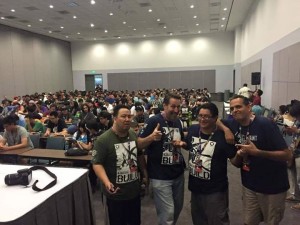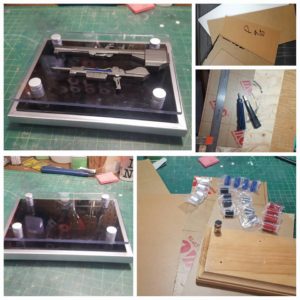First and foremost, Happy Lunar New Year‘s Eve for everyone on this side of the international date line. For the rest, Happy New Years! This past Sunday, we had a family dinner at one of the local Hong Kong style seafood restaurants. Randomly hearing the managers exclaim “Pig Parade” in Cantonese, and noticing all the staff rush to the kitchen; a slight hush came over the fully packed restaurant. The staff all come out of the kitchen with roasted pigs on huge metal prongs and proceeded to parade it around the restaurant. That the restaurant was packed and there was a line waiting to eat on a Sunday night was the very first clue that Chinese New Years was right around the corner.
I’ve also got some Saz updates as well as a potential canine addition to the household.
Ok, with that jazz out of the way, on to the Saz progress. The work has slowed a bit due to some issues I’ve been having with the resin casting. Of late, the resin has been slow to cure, and in some cases, not curing at all. I figured that the resin I have has gone bad as the shelf live is roughly 6 months from the the time it’s opened and exposed to air. I went out and picked up some new resin, but rather than wasting the resin I still have, I decided to do a little test. My research showed that the resin should be stored at 75°-80° F; I placed the bottles into a hot water bath to heat up the liquid before casting. And the results were amazing, the resin fully cured in a very fast time. An interesting lesson to learn: environment variable play a big part in model building chemicals.
With the resin casting problem resolved, I can return to working. I molded and cast the thruster bell piece from the Saz’s shoulder frame. With the thruster bells cast, the tops were drilled out in accordance to the size of the 1.8mm LEDs. The LEDs were then glued to the resin thruster bells with CA glue, and left to set for a few minutes.
Next, a mold of the entire plastic thruster part is made. The LED/thruster assembly above is then masked with some sticky tack and then shoved into the new mold.
Resin is poured into the mold and once cured, we have the resulting part: an LED integrated thruster assembly.
The part is then wired up and tested out in standalone as well as test fitted into the shoulder piece. Now that this part production is successful I can now cast two more to create the other shoulder piece as well as the additional third thruster for each assembly.
Next up is a return to explain the process for implementing the LED in the Saz’s mono eye. From the last post, all I have is the text description and pictures of the completed assembly. Here is the full explanation. I start out with the mono eye ring, the head, and the LED. The LED is bent and shaped for reasons that will soon become clear.
The head’s frame is only slightly modified. Some holes are drilled at the back for threading the LED leads, and the connection point for the mono eye ring is cut away slightly. The mono eye ring is modified with a metal collar replacing the plastic nub. A hole aligned with the metal collar is drilled through the mono eye ring. The LED implementation is fairly simple. The LED bulb drops into the frame’s connecting point with the mono eye, and with the slight modification to the frame, the mono eye will stay lit when moving side to side, keeping the original designed gimmick in tact.
Temporarily, the top piece of the LED is covered with some sticky tack so the only light emits through the mono eye. The top of the Saz’s head piece is also modified. The internal frame sections are cut and sanded down to accommodate the LED and leads.
And after all that, we have the completed assembly as seen in the previous post:
Time for a little discussion on LED implementation. There exists no single method for LED implementation. It differs with each kit’s design, size, LED size, power source, etc etc. With the past few recent kits, I’ve been on an damn LED kick. The GN-X was a really quick mod to an existing LED GN drive assembly by simply replacing the blub to a different color. The Gouf was a fairly simple self contained LED system stored inside the head. I’ve had kits with wires running through the entire kit down to a base and standalone systems with battery units inside the kit. It’s all about design and how innovative you want to get.
With the Saz, the leg boosters were very easy, as they were fairly large; the parts could accommodate 3mm sized LEDs. The parts were drilled and the LEDs slide into place. The same was done for the waist thrusters and large back thruster. Such mods are very easy to integrate. But when it came to the little shoulder thrusters, I was at a lost. They are tiny. I had been waffling back and forth on if I wanted to integrate lights for them. Ideas from running fiber optics to using surface mounts. I had all but destroyed one of the thruster frame assemblies while trying to integrate it with surface mount LEDs. I could have also just built the entire thruster assembly from scratch. But this was an option I was saving as a last ditch attempt. Having destroyed one of the thruster assemblies, I decided to mold and cast the remaining good thruster. After molding and casting the part, the idea to integrate the LED started forming in my head. And as seen in the above post, it worked out. Sure, it could use a little clean up and the process can be easily refined, but the general idea worked.
The reason for this discussion is to further illustrate that there is no single method for LED implementation. Or just making modifications in general. It’s always best to plan out things and experiment here and there. The important part is that all this is damn fun.




















